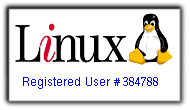More Adventures in Linux 0
It’s been a month now since I ported my Dell Inspiron laptop over to Linux, and I make progress every day.
Immediately after the installation, I had basic functionality–three browsers and several email application come with Slackware Linux, along with the KOffice Suite and numerous other applications selected by Pat Volkerding, the creator of Slackware, but I quickly downloaded Opera and got it working for email and text newsgroups.
Even before that, I got F-Prot Anti-Virus (which is free for home use) and a firewall working. Whenever I put a computer on the internet, those are my first priorities. I have no intention of running naked through the internet.
I installed Gnome. I don’t use the Gnome interface; I like the look and feel of KDE better, but a lot of the software I use needs libraries (for Windows users, that’s sort of like DLLs) that are part of Gnome.
For binary newsgroups, I went with Pan. To do parity checks on multipart posts, I selected par2cmdline. In Windows, I had been using QuickPar.
To manage split files (*.001, *.002, and so on) I first tried to use HJSplitLX (I have used the Windows version for years), but, despite my having the correct libaries on my machine, it didn’t like me. Then I found KSplit. And, natch, to decode the posts, I downloaded and registered Rar for Linux. Again, I’ve used the Windows version for a long time.
Slackware initially saw both my built-in CD r+w DVD r drive and my external CD r+w DVD r+w drive as plain CD-r drives, but it was the work of only a few minutes and not much Googling to get it to see them as rw drives (the trick is to mount them as SCSI drives–because they are r+w, Linux considers them to be just another type of HDD). I also found a CD/DVD burning program for the K Desktop Environment (KDE) that I really like.
Last weekend, I got Open Office working. OO comes in Fedora, Mandrake, and Suse Linux versions, but not in a plain vanilla Linux version; Slackware is classic Linux, without a bunch of proprietary garbage added to it (I think that’s why I like it). The Open Office Slack Build script converted it into a format that could load in Slackware.
(For you Windows users out there, Open Office also comes in a Windows version; it opens MS Word and other documents flawlessly and also saves in MS Word *.doc format. My son uses it on our Windows computer to do his homework. It gives you a full-featured office suite with an open source license. That means it’s free as long as you observe the terms of the license.)
I also got my printer working. The Lexmark didn’t like Linux, even though Lexmark publishes Linux drivers; I posted a question to the newsgroup, alt.os.linux.slackware and was emphatically told, dump the Lexmark. I didn’t want to, but realized, I also had an Epson attached to the Windows box. So I swapped the Lexmark and the Epson. It works perfectly, just as promised.
Last night, with the help of this webpage, I got my digital camera to mount with Linux. Once again, Linux sees the camera as if it were another HDD and mounts it as a read-only SCSI drive.
To play *.wmv media (Windows Media files), I followed the instructions in this post and grabbed the codecs here. I downloaded the “essential” codec package and put it in /usr/lib/win32 so GXine and Xine could find it. There was no installation required; I simply dropped the files in place.
Left to do:
.
Of course, I’m now stuck with a bunch of excellent Windows software I now longer need. If you’re interest in highgrade Windows utilities and programs, drop me a note.









